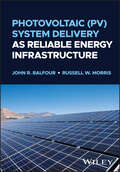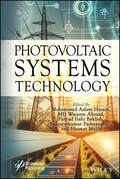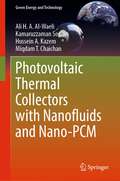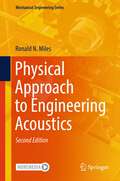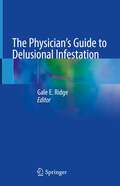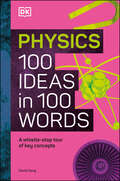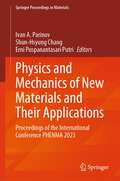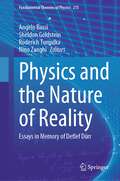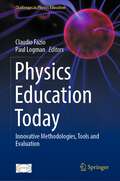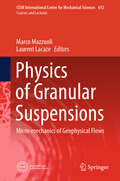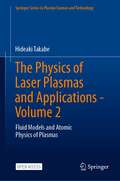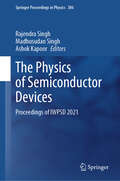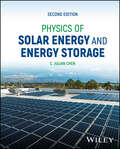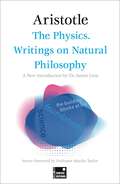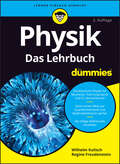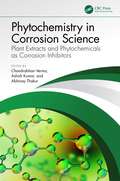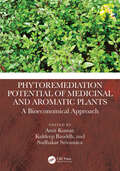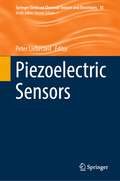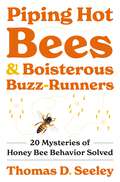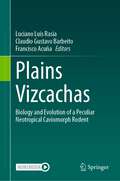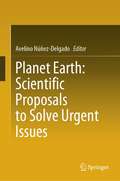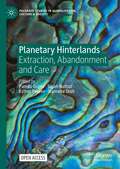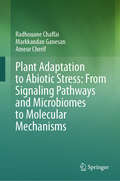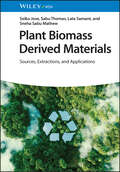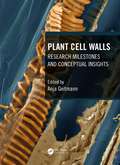- Table View
- List View
Photovoltaic (PV) System Delivery as Reliable Energy Infrastructure
by John R. Balfour Russell W. MorrisPHOTOVOLTAIC (PV) SYSTEM DELIVERY AS RELIABLE ENERGY INFRASTRUCTURE A practical guide to improving photovoltaic power plant lifecycle performance and output Photovoltaic (PV) System Delivery as Reliable Energy Infrastructure introduces a Preemptive Analytical Maintenance (PAM) for photovoltaic systems engineering, and the Repowering™ planning approach, as a structured integrated system delivery process. A team of veteran photovoltaics professionals delivers a robust discussion of the lessons learned from mature industries—including PV, aerospace, utilities, rail, marine, and automotive—as applied to the photovoltaic industry. The book offers real-world “technical and fiscal” examples of the impact of photovoltaics to all stakeholders during the concept, specification, operations, maintenance, and Repowering™ phases. In each chapter, readers will learn to develop RAMS specifications, reliability data collection, and tasks while becoming familiar with the inherent benefits of how these affect the cost of design and development, maintenance, spares, and systems operation. The authors also explain when and how to consider and implement Repowering™, plant upgrades and the considerations from concept through retirement and disposal of the plant. Readers will also find: A thorough introduction to Preemptive Analytical Maintenance (PAM), including systems engineering, lifecycle planning, risk management, risk assessment, risk reduction, as compared to the historic utility models, An in-depth treatment of the modern photovoltaic industry, including economic factors and the present endlessly evolving state of technology, Constructive discussions and application of systems engineering, including RAMS and System Engineering practices and solutions, Extensive explorations and application of data collection, curation, and analysis for PV systems, including advanced sensor technologies. Perfect for all new through to experienced photovoltaic design and specification engineers, photovoltaic plant owners, operators, PV asset managers and all interested stakeholders. Photovoltaic (PV) System Delivery as Reliable Energy Infrastructure will also earn a place in the libraries of utilities, engineering, procurements, construction professionals and students.
Photovoltaic Systems Technology
by Hasmat Malik P. Sanjeevikumar Farhad Ilahi Bakhsh Mohammed Aslam Husain Md Waseem AhmadPHOTOVOLTAIC SYSTEMS TECHNOLOGY Discover comprehensive insights into the latest advancements in solar PV technology, including power electronics, maximum power point tracking schemes, and forecasting techniques, with a focus on improving the performance of PV systems. A huge number of research articles and books have been published in the last two decades, covering different issues of PV efficiency, circuits, and systems for power processing and their related control. Books that have been published cover one or more topics but altogether fail to give a complete picture of the different aspects of PV systems. Photovoltaic Systems Technology aims to close the gap by providing a comprehensive review of techniques/practices that are dedicated to improving the performance of PV systems. The book is divided into three parts: the first part is dedicated to advancements in power electronic converters for PV systems; tools and techniques for maximum power point tracking of PV systems will be covered in the second part of the book; and the third part covers advancements in techniques for solar PV forecasting. The overall focus of the book is to highlight the advancements in modeling, design, performance under faulty conditions, forecasting, and application of solar photovoltaic (PV) systems using metaheuristic, evolutionary computation, machine learning, and AI approaches. It is intended for researchers and engineers aspiring to learn about the latest advancements in solar PV technology with emphasis on power electronics involved, maximum power point tracking (MPPT) schemes, and forecasting techniques.
Photovoltaic Thermal Collectors with Nanofluids and Nano-PCM (Green Energy and Technology)
by Ali H. Al-Waeli Kamaruzzaman Sopian Hussein A. Kazem Miqdam T. ChaichanThis book gives you theory and design of PV/T systems. Are you interested in solar energy? If you are, you must have read about solar panels, or photovoltaics (PV). If you have installed a photovoltaic system, you must have noticed it not to generate the amount of power mentioned in its datasheet. A major issue that PV suffers from is its temperature, which causes a drop in its power. Among the solutions to this issue is to use active cooling methods, such as the hybrid photovoltaic thermal (PV/T) system. These systems can produce electrical and thermal energy simultaneously and within same area. The thermal collector serves to cool down the PV surface temperature, which negatively affects the PV efficiency, to reclaim the efficiency or bring it back close to standard testing conditions value. Moreover, the thermal collector will convey this heat using a working fluid and extract it as thermal energy. On the other hand, the electrical power generated from the PV can be utilized in standalone or grid-connected configuration. Moreover, the book presents a novel PV/T collector which can utilize nanofluids and nano-Phase Change Material (PCM) to enhance its performance in tropical climate conditions. The methods used to develop the heat transfer and energy balance equations are presented as well. PV/T collector numerical simulation using MATLAB and computational fluid dynamic (CFD) was also presented. Finally, the approach of life cycle cost analysis (LCCA) is presented to evaluate PV/T with nanofluid and nano-PCM, economically.
Physical Approach to Engineering Acoustics (Mechanical Engineering Series)
by Ronald N. MilesThis updated edition adds new material on the acoustics of mufflers and ducts, including a new analysis on sound propagation in a duct having a cross sectional area that varies in the direction of the duct length. The textbook retains its class-tested fundamentals of engineering acoustics and examination of in-depth concepts within the domains that apply to reducing noise, measuring noise, and designing microphones and loudspeakers. The book particularly emphasizes the physical principles used in designing miniature microphones. These devices are used in billions of electronic products, most visibly, cell phones and hearing aids, and enable countless other applications. Distinct from earlier books on this topic that take the view of the electrical engineer analyzing mechanical systems using electric circuit analogies. This text uses Newtonian mechanics as a more appropriate paradigm for analyzing these mechanical systems and in so doing provides a more direct method of modeling. Written at a level appropriate for upper-division undergraduate and graduate courses, and enhanced with end-of-chapter problems and MatLab routines, the book is ideal as a core text for students interested in engineering acoustics in ME, EE, and physics programs, as well as a reference for engineers and technicians working in the huge global industry of miniature microphone design.
The Physician's Guide to Delusional Infestation
by Gale E. RidgeThis unique, ground-breaking book is a comprehensive clinical guide to the psychiatric disorder of Delusional Infestation (DI). DI is a psychiatric illness characterized by patients holding a monothematic fixed belief of infestations on their skin, body, or immediate environment - a belief that is not supported by objective medical evidence. Delusional beliefs may be shared among individuals, and perceived pathogens include living organisms such as parasitic worms, bacteria, fungi, and insects. Organic or non-organic infiltration by fibres, threads, or other inanimate particles or objects, known or unknown to medical science, are also described by patients. DI is severely underreported because of social stigma, limited physician awareness, and patient doctor-hopping.Written for physicians, the book offers a multidisciplinary, compassionate care model for patients burdened by this pernicious disorder. Other health professionals and administrators will find the work highly valuable, as will professionals in fields such as veterinary medicine, pest management, entomology, parasitology, and information services supported by academia.The Physician’s Guide to Delusional Infestation assembles and organizes all current knowledge of DI and presents material in three parts. Part I introduces and reviews DI’s historical background, showing how our understanding of the condition has developed. Its concise sections include useful tables, illustrations, algorithms, and reference lists for clinicians who work with DI patients.Part II covers differential diagnosis, treatment, and ways to work effectively with DI patients. Since these patients are often high-functioning, particular techniques of interviewing, joining with patients, sampling, and laboratory testing are explained. International travel, physician fallibilities, possible alternative diagnoses, the Internet, and veterinary and public health concerns are all addressed.PartIII is a series of chapters written by experts in their fields. This section allows each author to present personal experiences from their respective professions -- observations and opinions that show a variety of perspectives among the book’s authors. Part III includes a chapter on common human parasites with their biology, behaviours, and distributions. The book will serve as a comprehensive, yet concise, reference for physicians whose patients have unusual, baffling, or implausible medical histories and physical examinations. A soon to be gold-standard resource, The Physician’s Guide to Delusional Infestation equips and empowers all physicians -- and many others interested in the topic -- with an expert, comprehensive understanding of this complex disorder.
Physics 100 Ideas in 100 Words: A Whistle-stop Tour of Science's Key Concepts
by DKGet to grips with the essential topics in physics today through 100 key ideas, each one explained clearly in 100 words.Physics: 100 Ideas in 100 Words offers the essential facts at your fingertips, satisfying your scientific curiosity and helping you to understand the biggest concepts in physics in concise, 100-word summaries. One of the first titles in a cutting-edge new series created in partnership with The Science Museum, this book introduces 100 key areas of physics such as gravity, motion, magnetism and quantum physics, and explains each topic in just 100 words. Perfect for getting your head around big ideas clearly and quickly, or refreshing your memory of the fundamentals of physics, this book covers the most up-to-date terms and theories and inspires a heightened level of understanding and enjoyment to the core areas of physics.
Physics and Mechanics of New Materials and Their Applications: Proceedings of the International Conference PHENMA 2023 (Springer Proceedings in Materials #41)
by Ivan A. Parinov Shun-Hsyung Chang Erni Puspanantasari PutriThis book presents 60 selected peer-reviewed contributions from the international conference Physics and Mechanics of New Materials and Their Applications, PHENMA 2023 (3-8 October, 2023, Surabaya, Indonesia), focusing on processing techniques, physics, mechanics, and applications of advanced materials. The book describes a broad spectrum of promising nanostructures, crystal structures, materials, and composites with unique properties. It presents nanotechnological design approaches, environmental-friendly processing techniques, and physicochemical as well as mechanical studies of advanced materials. The selected contributions describe recent progress in energy harvesting and piezoelectric materials optimization, electromagnetoelastic actuators for nanotechnology research, impedance spectroscopy and study of ceramic materials, catalyst synthesis and control of morphological characteristics, synthesis and study of electrocatalysts for fuel cells. The presented results are important forongoing efforts concerning the theory, modelling, and testing of advanced materials. Other results are devoted to the analysis of technogenic raw materials and different material applications in science, technique and industry.
Physics and the Nature of Reality: Essays in Memory of Detlef Dürr (Fundamental Theories of Physics #215)
by Angelo Bassi Sheldon Goldstein Roderich Tumulka Nino ZanghìThis volume commemorates the scientific contributions of Detlef Dürr (1951–2021) to foundational questions of physics. It presents new contributions from his former students, collaborators, and colleagues about their current research on topics inspired or influenced by Dürr. These topics are drawn from physics, mathematics, and philosophy of nature, and concern interpretations of quantum theory, new developments of Bohmian mechanics, the role of typicality, quantum physics in relativistic space-time, classical and quantum electrodynamics, and statistical mechanics. The volume thus also gives a snapshot of present research in the foundations of physics.
Physics Education Today: Innovative Methodologies, Tools and Evaluation (Challenges in Physics Education)
by Claudio Fazio Paul LogmanThis book provides an in-depth exploration of the latest developments in physics education. It presents a comprehensive look into cutting-edge research and ideas used to improve physics education around the world. Topics covered include (but are not limited to) the use of problem-based learning, the design and evaluation of teaching materials, and the use of digital technologies. This book is essential for anyone looking to stay up-to-date on the latest educational innovations and to develop an understanding of effective teaching approaches. It is aimed at researchers, teachers, students, policymakers, and educational leaders in the field of physics education.
Physics of Granular Suspensions: Micro-mechanics of Geophysical Flows (CISM International Centre for Mechanical Sciences #612)
by Marco Mazzuoli Laurent LacazeThis book provides graduate students and scientists with fundamental knowledge on the mechanics of granular suspensions as well as on the mathematical and numerical techniques that can be adopted to investigate geophysical flows. To this end, three formidably complex problems (sediment transport, flow-like landslide inception, and gravity currents) are considered. The reader will find a thorough combination of elements of fluid and solid mechanics, rheology, geotechnics, geomorphology, civil, and coastal engineering. The first part of the book introduces the problem of granular suspensions from the mathematical viewpoint, focusing on issues that characterise geophysical flows such as turbulence, the effects of inter-particle contacts, and strong velocity gradients. In the second part, different models that were successfully used to investigate the mechanics of granular suspensions in environmental flows are presented.
The Physics of Laser Plasmas and Applications - Volume 2: Fluid Models and Atomic Physics of Plasmas (Springer Series in Plasma Science and Technology)
by Hideaki TakabeThis open access book (Volume 2) is part of the series "The Physics of Laser Plasmas and Applications." It serves as an introduction to the physics of compressible hydrodynamics, which is used to describe the temporal evolution of plasmas generated by intense laser irradiation of solid surfaces. For the benefit of students and young researchers, the book presents the fundamental equations and provides a comprehensible explanation of solutions to intricate fluid phenomena. It builds upon the concept of plasma generation through the heating of matter via the classical absorption of a laser, as expounded in Volume 1. The high-temperature plasma resulting from the laser interaction manifests in diverse hydrodynamic occurrences like shock waves and expansion waves. The initial sections of this book expound the essentials of compressible hydrodynamics, magnetohydrodynamics (MHD), and the physics of shock waves. The transfer of laser energy within an expanding plasma towards regions of higher density is achieved through electron and X-ray transport mechanisms. In both instances, conventional diffusion models prove inadequate, necessitating mathematical frameworks founded on the Boltzmann equation. The conveyed energy engenders ablation pressure, equivalent to tens of millions of atmospheres, on the solid surface. This pressure initiates powerful shock waves propagating through the solid material. The propagation of these shock waves is delineated for scenarios involving planar and spherical geometries. The text also introduces various solutions pertaining to convergent and divergent shocks in spherical geometries using self-similar models. The discourse then shifts towards ionization and related atomic processes, which govern the dynamics of plasmas created by laser irradiation of mid-Z and high-Z solids. The quantum mechanics of partially ionized atoms and their associated atomic processes are elucidated. Concluding the book is an exploration of the physics of warm dense matter (WDM) – an electron system characterized by quantum-mechanical, many-body interactions. The study of high-density plasmas featuring temperatures around 1 eV is undertaken through the lens of density functional theory (DFT). The theoretical breakdown of experimental data acquired via the X-ray free electron laser (X-FEL) is also provided. In essence, this second volume of the series amalgamates a comprehensive understanding of compressible hydrodynamics, shock wave physics, ionization processes, energy transfer, and the realm of warm dense matter. It equips readers to delve into the intricacies of plasma physics and laser interactions while utilizing modern theoretical frameworks and experimental methodologies.This is an open access book.
The Physics of Semiconductor Devices: Proceedings of IWPSD 2021 (Springer Proceedings in Physics #306)
by Rajendra Singh Madhusudan Singh Ashok KapoorThis book includes proceedings of the 21st International Workshop on Physics of Semiconductor Devices. The workshop is jointly organized by the Indian Institute of Technology, Delhi, and Solid State Physics Laboratory, Delhi, in collaboration with the Society for Semiconductor Devices and Semiconductor Society of India. This book disseminates the current knowledge of semiconductor physics and its applications across the scientific community. It is based on a biennial workshop that provides the participating research groups with a stimulating platform for interaction and collaboration with colleagues from the same scientific community. The book discusses the latest developments in III-nitrides; materials and devices, compound semiconductors, VLSI technology, optoelectronics, sensors, photovoltaics, crystal growth, epitaxy, and characterization, graphene, and other 2D materials and organic semiconductors. The research articles included in this book are contributed by various eminent scientists from all over the world. The book serves as a reference resource for researchers and practitioners in academia and industry.
Physics of Solar Energy and Energy Storage
by C. Julian ChenPHYSICS OF SOLAR ENERGY AND ENERGY STORAGE Join the fight for a renewable world with this indispensable introduction Solar energy is one of the most essential tools in the fight to create a sustainable future. A wholly renewable and cost-effective energy source capable of providing domestic, business, and industrial energy, solar energy is expected to become a $223 billion a year industry by 2026. The future of global energy production demands researchers and engineers who understand the physics of harnessing, storing, and distributing solar energy. Physics of Solar Energy and Energy Storage begins to meet this demand, with a thorough, accessible overview of the required fundamentals. Now fully updated to reflect the past decade of research amidst a growing understanding of the scale of our collective challenge, it promises to train the next generation of researchers and engineers who will join this vital effort. Readers of the second edition of Physics of Solar Energy and Energy Storage will find: A particular focus on lithium-ion rechargeable batteries Detailed discussions of photovoltaic solar systems, concentrating solar systems, passive solar heating, and more Homework problems and exercises throughout to reinforce learning Physics of Solar Energy and Energy Storage is ideal for mechanical, chemical, or electrical engineers working on solar or alternative energy projects, as well as researchers and policymakers in related fields.
The Physics. Writings on Natural Philosophy (Foundations)
by AristotleAristotle's great work that laid the foundations for Galileo, Isaac Newton and Albert Einstein's much later discoveries about the natural laws of life and the universe.In the philosophical language of Aristotle and the Greeks of Antiquity, 'Physics' roughly translates as 'the order of nature', covering what we would now differentiate as philosophy, science, politics, humanities and religion. One of Aristotle's great works, of which we here present an abridged edition, The Physics is an investigation into the nature of being, of the world and its place in the universe. Although philosophically much broader, it provides the foundation for the later work of Galileo and Isaac Newton, and prefigures Albert Einstein's breakthrough theories on time, space and the motion of stars.The FLAME TREE Foundations series features core publications which together have shaped the cultural landscape of the modern world, with cutting-edge research distilled into pocket guides designed to be both accessible and informative.
Physik für Dummies: Das Lehrbuch (Für Dummies)
by Wilhelm Kulisch Regine FreudensteinDie Physik auf etwas mehr als einen Blick Physik kann ganz schön kompliziert sein, besonders wenn es etwas mehr in die Tiefe geht. Dass man aber auch komplizierte Dinge leicht verständlich und bisweilen amüsant erklären kann, beweist dieses Buch. Wilhelm Kulisch und Regine Freudenstein erläutern, was Sie über Mechanik, Kontinuumsmechanik, Schwingungen, Wellen, Elektromagnetismus, Thermodynamik und Optik wissen sollten. Aber auch die makroskopische und mikroskopische moderne Physik kommen mit Relativitätstheorie und Quantenphysik nicht zu kurz. Zahlreiche Übungsaufgaben mit Lösungen runden das Buch ab. Sie erfahren Was Kapazität, magnetische Induktion und Halbleiter sind Was es mit der Wellennatur des Lichts, der Polarisation und dem elektromagnetischen Spektrum auf sich hat Was es zu Pulsaren, schwarzen Löchern und der Urknalltheorie zu wissen gibt
Phytochemistry in Corrosion Science: Plant Extracts and Phytochemicals as Corrosion Inhibitors
by Chandrabhan VermaPhytochemistry in Corrosion Science covers the use of plant extracts/phytochemicals in corrosion mitigation with industrial applications. It explores innovative and characterization approaches toward the utilization of plant extracts and their phytochemicals as potential corrosion inhibitors for several metals and their alloys.Providing a comprehensive overview of the green aspects of plant extracts as corrosion inhibitors, this book discusses the preparation of aqueous and organic phase extracts, and their advantages, disadvantages, and use for different aggressive media. It also examines aqueous and organic extracts that have been successfully used as corrosion inhibitors for various metals and electrolyte combinations.This book will be a useful reference for undergraduate and graduate students and academic researchers in the fields of phytochemistry, corrosion science and engineering, environmental science, chemical engineering, green chemistry, and mechanical/industrial engineering.
Phytoremediation Potential of Medicinal and Aromatic Plants: A Bioeconomical Approach
by Amit Kumar Kuldeep Bauddh Sudhakar SrivastavaEnvironmental contamination of heavy metals is a major problem, threatening sustainable agricultural production and health of millions of people. The extensive distribution of heavy metals in soil and water makes it necessary to employ environment-friendly low-cost and sustainable approaches for the remediation of contaminated sites. Phytoremediation has been considered a viable approach to meet these demands; however, it must provide some economic gains too. The use of economically important medicinal and aromatic plants is helpful in restoration of metal-contaminated sites and also may provide economic gains to the farmers. The book brings about a critical overview of the prospects of utilizing medicinal and aromatic plants in phytoremediation, including their utility, economic benefits and human safety issues. The book will be a timely addition to the field and would act as landmark. This book is of interest to teachers, researchers, doctoral and graduate students working in the area of environmental pollution and cleanup technologies. The students working in the field of metal(loid) stress and crop biofortification will also find this to be a useful read. The content of the book is presented in simple language and represented through beautiful and scientifically informative figures and tables.
Piezoelectric Sensors (Springer Series on Chemical Sensors and Biosensors #18)
by Peter LieberzeitThis book provides a comprehensive overview of piezoelectric sensor devices and instrumentation and their use for chemical and biochemical analysis. Sensors relying on established transducers, such as the quartz crystal microbalance (QCM) and the surface acoustic wave resonator (SAW) are covered, and novel devices like surface transverse wave (STW) resonators, film bulk acoustic resonators (FBAR) as well as non-piezoelectric devices with mass-sensitive properties are presented. As their name implies, such devices respond directly to mass changes on their surfaces and thus address the most fundamental quality of any analytes. First, the book presents the fundamentals of new measuring strategies with these devices. Then, it introduces a variety of chemo- and biosensing application scenarios of these devices. In addition, the book covers both the state-of-the-art of academic research and prospects concerning the commercialization of these sensors. Given its scope, the book is of interest to academics, specialists in industry, and advanced students in the areas of analytical chemistry, rapid analysis, and sensor technology, giving them the unique possibility to familiarize themselves with this chemical sensing strategy. Readers will benefit from the coverage of both cutting-edge research results and applications that help bridge the gap between academia and industry.
Piping Hot Bees and Boisterous Buzz-Runners: 20 Mysteries of Honey Bee Behavior Solved
by Thomas D. SeeleyA biologist&’s up-close account of how he and fellow biologists cracked long-standing puzzles about honey bee behaviorPiping Hot Bees and Boisterous Buzz-Runners takes readers inside a world seldom seen even by beekeepers, shedding light on twenty of the most compelling mysteries of honey bee behavior.Thomas Seeley has devoted a lifetime to the study of honey bees and their colonies, unraveling the secrets of these wondrous insects in a career spanning six decades. In this book, he weaves illuminating personal stories with the latest science, explaining such mysteries as how worker bees function as scouts to choose a home site for their colony, furnish their home with beeswax combs, and stock it with brood and food while keeping tens of thousands of colony inhabitants warm and defended from intruders. Along the way, he shares the experiences that drew him to these studies, the small observations that led to big breakthroughs, and the sense of excitement that came with probing each mystery.Richly illustrated, Piping Hot Bees and Boisterous Buzz-Runners provides a rare look at how a singularly passionate scientist and his colleagues deciphered the pipings, shakings, and puzzling tremble dances of honey bees, and how this journey of scientific discovery continues to shape our understanding of these remarkably intelligent and vitally important insects.
Plains Vizcachas: Biology and Evolution of a Peculiar Neotropical Caviomorph Rodent
by Luciano Luis Rasia Claudio Gustavo Barbeito Francisco AcuñaThe plains vizcacha (Lagostomus maximus) is a remarkable rodent of the Neotropic given several peculiar aspects of its biology, some of them quite unique among rodents or even among mammals. This book gathers specialists studying plains vizcachas from very different approaches, including paleontology, systematics, morphology, physiology, development and conservation. It is divided in two Parts, 1) Evolutionary History, and 2) Morphology, Development and Physiology. It will surely be a required reading for any researcher working with caviomorph rodents, mastozoology of the Neotropics or internal anatomy and physiology of mammals.
Planet Earth: Scientific Proposals to Solve Urgent Issues
by Avelino Núñez-DelgadoThis book represents the most comprehensive overview of issues affecting our planet and the forefront solutions, including climate change, air, water, soil pollution, demography, and access to food and water. This edited book, led by Prof. Núñez-Delgado, counts with the participation of leading researchers across a wide range of disciplines to be an inspiring and motivating document to promote sustainability and biodiversity. Those of you asking for trustworthy analyses about sustainability and climate change and the vanguard solutions will find this book fascinating.
Planetary Hinterlands: Extraction, Abandonment and Care (Palgrave Studies in Globalization, Culture and Society)
by Pamila Gupta Sarah Nuttall Esther Peeren Hanneke StuitThis open access book considers the concept of the hinterland as a crucial tool for understanding the global and planetary present as a time defined by the lasting legacies of colonialism, increasing labor precarity under late capitalist regimes, and looming climate disasters. Traditionally seen to serve a (colonial) port or market town, the hinterland here becomes a lens to attend to the times and spaces shaped and experienced across the received categories of the urban, rural, wilderness or nature. In straddling these categories, the concept of the hinterland foregrounds the human and more-than-human lively processes and forms of care that go on even in sites defined by capitalist extraction and political abandonment. Bringing together scholars from the humanities and social sciences, the book rethinks hinterland materialities, affectivities, and ecologies across places and cultural imaginations, Global North and South, urban and rural, and land and water.
Plant Adaptation to Abiotic Stress: From Signaling Pathways and Microbiomes to Molecular Mechanisms
by Radhouane Chaffai Markkandan Ganesan Ameur CherifThe book “Plant Adaptation to Abiotic Stress: From Signaling Pathways and Microbiomes to Molecular Mechanisms” comprehensively examines abiotic stressors—cold, heat, light, salinity, and water scarcity—across its 18 chapters. Focusing particularly on Arabidopsis thaliana, it investigates abiotic stresses, adaptation strategies, and molecular pathways. Furthermore, it addresses broader issues, including climate challenges, food security, water scarcity, and agricultural concerns such as soil acidity and aluminum stress. It proposes adaptive measures for cultivating stress-resistant crops and sheds light on genetic modification methods such as CRISPR-Cas9, integrating nanotechnology in plant breeding. Emphasizing transcription factors, post-translational protein modifications, and diverse noncoding RNAs (long noncoding RNAs, circular RNAs, microRNAs, and small interfering RNAs), the book highlights their role in regulating gene expression during stress responses. It specifically underscores secondary messengers, plant hormones, and MAPK cascades within intracellular signaling pathways. Additionally, it discusses the roles of endophytic bacteria and microbial interactions in bolstering stress resilience. The book explores state-of-the-art research methodologies in plant breeding, omics approaches, and nanotechnology integration for developing stress-resistant crop varieties, advocating for agricultural sustainability. Tailored for plant physiology scientists, academics, and postgraduate students, it amalgamates diverse research findings, serving as a pivotal resource to comprehend intricate plant responses to environmental challenges.
Plant Biomass Derived Materials: Sources, Extractions, and Applications
by Seiko Jose Sabu Thomas Lata Samant Sneha Sabu MathewPlant Biomass Derived Materials Comprehensive overview of materials derived from biomass, including extraction techniques, important building blocks, and a wide range of applications Plant Biomass Derived Materials provides insights into the different sources and kinds of biomass and covers a variety of techniques to derive important building blocks from raw resources; after foundational knowledge is covered, the text continues to discuss a comprehensive list of materials and applications, ranging from nanomaterials, polymers, enzymes, dyes, and composites, to applications in energy, biomedical, water purification, aeronautics, automotive and food applications, and more. Written by four highly qualified authors with significant experience in both industry and academia, Plant Biomass Derived Materials includes information on: Biomass and its relationship to the environment, chemistry of biomass, lignin and starch, and recent trends of cashew nutshell liquid in the field Plant biomass mucilage, plant based colorants, revival of sustainable fungal based natural pigments, and algal-based natural pigments for textiles Biorefinery from plant biomass (including a case study in sugarcane straw), forest and agricultural biomass, and manufacture of monomers and precursors Chemical routes for the transformation of bio-monomers into polymers and manufacture of polymer composites from plant fibers Providing foundational knowledge on the subject and a wide array of specific applications of biomass, Plant Biomass Derived Materials is an essential resource for chemists, materials scientists, and all academics and professionals in fields that intersect with biomass: an abundant renewable resource used for many diverse purposes.
Plant Cell Walls: Research Milestones and Conceptual Insights
by Anja GeitmannPlant cell walls have been relevant for human survival throughout evolution, from cell walls recognised as an essential ingredient in human and livestock nutrition, to their use in energy generation, construction, tool making, paper and clothing. This plant-generated material is at the centre of a myriad of human activities, and it represents the world's most abundant natural resource for fuel, fibre, food and fodder. Plant Cell Walls: Research Milestones and Conceptual Insights provides an overview of the key discoveries of hundreds of years of plant cell wall research. With chapter contributions from prominent scientists in the cell wall field, this book provides a comprehensive treatment of plant cell wall research, accompanied by a historical overview to illustrate how concepts have evolved, and how progress has been enabled by emerging technological advances. Plant Cell Walls: Research Milestones and Conceptual Insights elaborates on the translation of research to application in biotechnology and agriculture, and highlights its relevance for climate change mitigation and adaptation. It will be a key resource for plant cell biologists, biochemists and geneticists.
